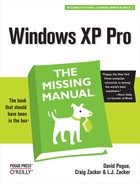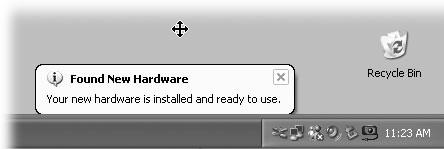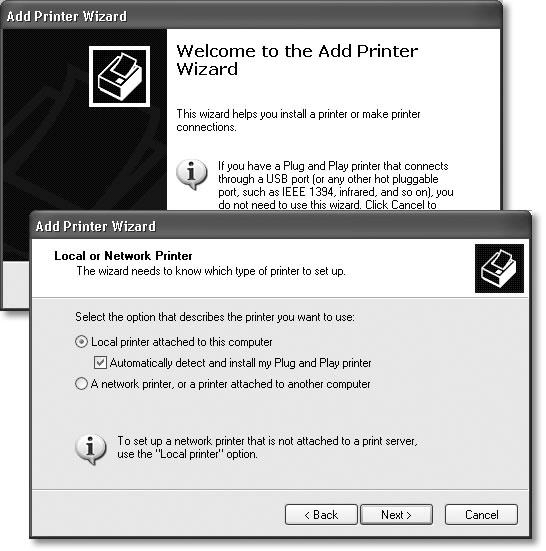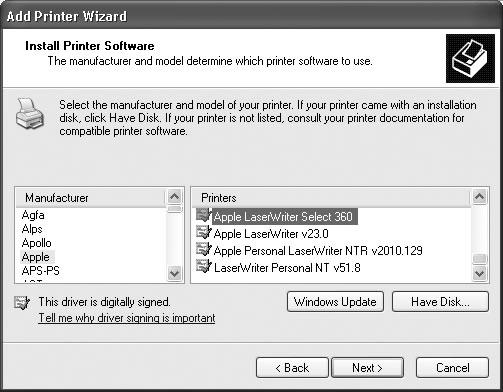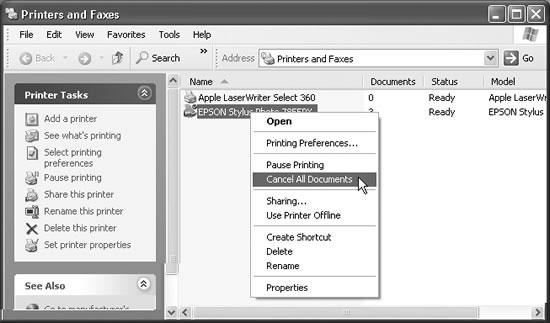Technologists got pretty excited about “the paperless office” in the eighties, but the PC explosion had exactly the opposite effect: Thanks to the proliferation of inexpensive, high-quality PC printers, we generate far more printouts than ever. There’s not much to printing from Windows XP, so this is a short chapter.
A printer is designed to follow computer instructions called printer codes from your PC. These codes tell the printer what fonts to use, how to set margins, which paper tray to use, and so on.
But the codes aren’t identical for every printer. Therefore, every printer requires a piece of software—the printer driver—that tells the printer how to interpret what it “hears” from your computer.
Windows XP comes with hundreds of printer drivers built right in; your printer also came with a set of drivers on a CD or floppy. You can often find more recent driver software for your printer on the manufacturer’s Web site, such as http://www.epson.com or http://www.lexmark.com, or from a central driver repository like http://www.windrivers.com.
Did you upgrade your PC to Windows XP from an earlier version—one that worked fine with your printer? In that case, Windows XP automatically notices and inherits your existing settings. If it’s a fairly recent printer with a fairly recent driver, it’ll probably work fine with Windows XP.
But if the printer is especially elderly, the printer software may be incompatible with Windows XP. In that case, your first activity after dinner should be to search the printer company’s Web site for an updated version, or check Microsoft’s master Windows XP compatibility list at http://www.microsoft.com/hcl.
If you just bought a new computer or a new printer, however, you’ll have to hook it up yourself and install its software. In general, there’s not much to it.
Note
Only people with Administrator accounts can install a new printer to a Windows XP machine (see Chapter 16).
If you’re like most people at home these days, you use an inkjet printer that connects to your PC’s USB (Universal Serial Bus) port. As a technology, USB has lots of advantages: USB gadgets are easy to connect and disconnect, are very fast, conserve space, can be plugged and unplugged while the PC is running, and so on.
Just the act of connecting a USB printer to your PC, for example, inspires Windows XP to dig into its own bag of included driver modules to install the correct one (Figure 13-1). See Chapter 14 for more on this process.
If you work in an office where numerous people on the network share a single laser printer, the printer usually isn’t connected directly to your computer. Instead, it’s elsewhere on the network; the Ethernet cable coming out of your PC connects you to it indirectly.
In general, there’s very little involved in ensuring that your PC “sees” this printer. Its icon simply shows up in the Start→Control Panel→Printers and Faxes folder. (If you don’t see it, run the Add Printer Wizard described in the following section. On its second screen, you’ll be offered the chance to look for “A network printer, or printer attached to another computer.” That’s the one you want.)
Although USB printers are the world’s most popular type today, there was, believe it or not, a time before USB. In those days, most home printers fell into one of these categories:
Parallel. Before USB changed the world, most printers connected to PCs using a printer cable or parallel cable. The cable connects to your PC’s parallel port, which Microsoft’s help screens call the LPT1 port—a 25-pin, D-shaped jack. (On many PCs, this connector is marked with a printer icon on the back panel.)
Serial. Other older printers use a cable connected to one of your computer’s serial (or COM) ports, the connectors that often accommodate an external modem. The primary advantage of a serial connection is the extended cable length: Parallel cables must be no more than nine feet long, while serial cables up to 50 feet long work fine.
Tip
To protect its innards, turn off the PC before connecting or disconnecting a parallel or serial cable.
Figure 13-2. Top: As the note explains, use the Add Printer Wizard only if your printer doesn’t connect to your USB or FireWire (IEEE 1394) port. Bottom: In this window, try the “Automatically detect and install my Plug and Play printer” option first, as shown here. If Windows can’t automatically detect the brand and model of the printer you’ve attached, return to this screen and turn off this option. You’ll wind up in the dialog box shown in the next illustration.
Infrared. Certain printers from HP, Canon, Citizen, and other companies print using infrared technology—that is, there’s no cable at all. Instead, if your PC has an infrared lens (as many laptops do), it can communicate with the printer’s similar lens wirelessly, as long as the printer and PC are within sight of, and relatively close to, each other.
If the technology gods are smiling, you can just connect the printer, turn on your Windows XP machine, and delight in the “Found new hardware” message that appears on your taskbar. You’re ready to print.
But if Windows doesn’t “know about” the printer model you’ve hooked up, it can’t install its drivers automatically. In that case, the Add Printer Wizard appears (Figure 13-2)—or you can always open it. (Choose Start→Control Panel→Printers and Faxes; click the Add Printer link.) Click Next to walk through the questions until you’ve correctly identified your printer and installed the appropriate software.
Here are the guidelines for using the next screen:
Try the “Automatically detect and install my Plug and Play printer” checkbox first (see Figure 13-2 at bottom). If it doesn’t succeed in locating your printer and installing the software, run the wizard again, this time turning that option off.
If the “Automatically detect” option didn’t work, you’ll be asked to specify which PC port your printer’s connected to. You’ll then be asked to indicate, from a gigantic scrolling list of every printer Microsoft has ever heard of, your exact brand and model (Figure 13-3).
Figure 13-3. The left pane lists every printer manufacturer Microsoft has ever heard of. Once you’ve selected your printer’s manufacturer, a list of all the printer models from that manufacturer (that Windows XP knows about) appears in the right pane. Click the Have Disk button if your printer’s driver software is on a disk supplied by the manufacturer.
At this point, you must lead Windows by the nose to the printer’s driver software. On the Add Printer Wizard screen, select your printer from the list of printers. If Windows doesn’t list your printer there, or if its manufacturer supplied the Windows XP driver on a disk, click the Have Disk button, and then navigate to the CD, floppy disk, or downloaded Internet installation file that contains the driver.
Either way, subsequent wizard screens will invite you to type a short name for your printer, in order to make it available to other computers on the network (yes, Windows can even share, for example, a USB inkjet, even though it’s not technically a network printer), to print a test page, and so on. (If the test page doesn’t print out correctly, Windows XP launches its printer troubleshooter—a specialized wizard that offers you one troubleshooting suggestion after another until either you or Windows quits in frustration.)
If your driver-installation efforts are ultimately successful, you’re rewarded by the appearance of an icon that represents your printer.
This icon appears in the Printers and Faxes window—an important window that you’ll be reading about over and over again in this chapter. Exactly how you arrive there depends on how you’ve set up Windows XP:
If you’ve set up your Start menu to display a submenu for the Control Panel (page 57), just choose Start→Control Panel→Printers and Faxes.
If you view your Control Panel in Classic view (Chapter 8), choose Start→Control Panel, and then open the Printers and Faxes icon.
If you view your Control Panel in Category view, choose Start→Control Panel, click the Printers and Other Hardware link, and finally click the “View installed printers or fax printers” link.
The Printers and Faxes window should be listed in your Start menu, which saves you some burrowing if you use this feature a lot. If it’s not there, for some reason, right-click the Start button. From the shortcut menu, choose Properties. On the Start Menu tab, click Customize, then click the Advanced tab. Scroll down in the list of checkboxes, and finally turn on “Printers and Faxes.” Click OK twice.
Figure 13-4. At first, the task pane in the Printers and Faxes window offers only two commands. But when you click a printer icon, a long list of useful options appears, as shown here. Many of them duplicate the options that appear when you right-click a printer icon—something you’d be wise to remember the day your right mouse button breaks.
Tip
If you’re using your Start menu in Classic view (Chapter 8), you get to your Printers and Faxes window by clicking Start→Settings→Printers and Faxes.
In any case, the Printers and Faxes window now contains an icon bearing the name you gave it during the installation (Figure 13-4). This printer icon comes in handy in several different situations, as the rest of this chapter clarifies.
